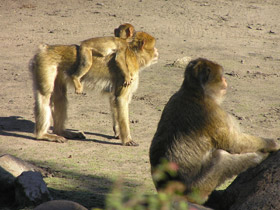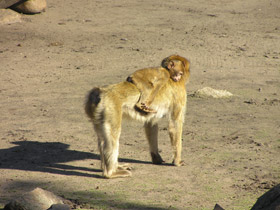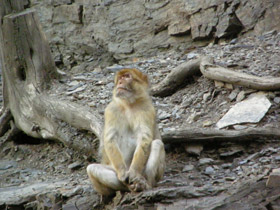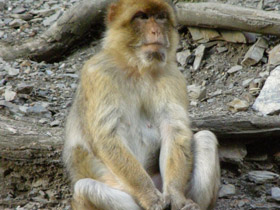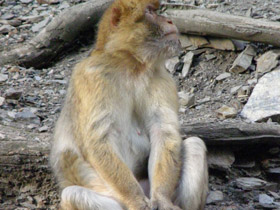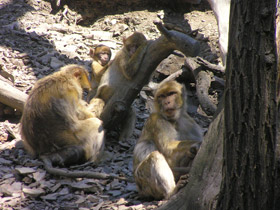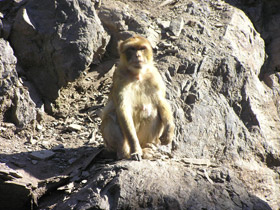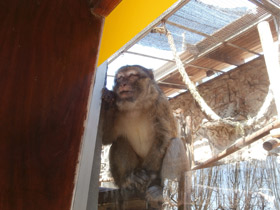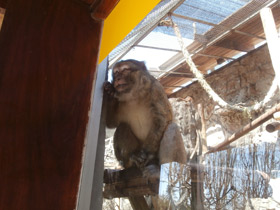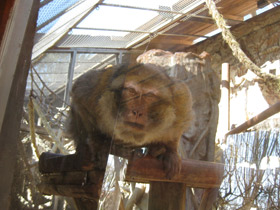The Barbary macaque or Barbary ape
 The Barbary macaque (Macaca sylvanus) is included in the IUCN Red List as a "threatened species"
The Barbary macaque (Macaca sylvanus) is included in the IUCN Red List as a "threatened species"
The Barbary macaque (Macaca sylvanus), also known as the Barbary ape, is a species of macaque native to the Atlas Mountains of Algeria, Tunisia and Morocco, along with a small introduced population in Gibraltar. It is the type species of the genus Macaca. The species is of special interest because males play an atypical role in breeding. Due to uncertain paternity, males are an integral part of the rearing of all offspring. Generally, Barbary macaques of both sexes and all ages contribute to the alloparental care of the offspring.
Habitat
Macaca sylvanus are different names for the only primate found in Europe. Macaca sylvanus is a species of catarrhine primate of the family Cercopithecidae.
Macaca sylvanus are common in the Atlas Mountains of Morocco, Algeria and Tunisia and on the Rock of Gibraltar. Fossil bones of Macaca sylvanus have been found in various parts of Europe and scientists speculate that Macaca sylvanus is what remains of an earlier, much larger European population. However, it is possible that Macaca sylvanus was introduced to Gibraltar by the Phoenicians or Romans.
Appearance
These apes reach a body length of 75-80 cm and weigh between 13 and 15 kg. Their limbs are long and slender, but strong and agile: it is not surprising that Macaca sylvanus are good climbers of trees and rocks. Covered in thick reddish-yellow fur, they can climb to an altitude of up to 2,300 metres and survive temperatures as low as -10 °C.
Taxonomy and phylogeny
The Barbary macaque is first described in scientific literature by Aristotle in the 4th century BC. History of Animals. He writes of an ape with "arms like those of a man, only covered with hair", "feet are exceptional in their kind ... like large hands", and "a tail as small as small can be, only a sort of indication of a tail". It is likely that Galen (129-c.216) dissected the Barbary macaque in the 2nd century AD, assuming that its internal structure was the same as that of a human. Such was the authority of his work that some errors he made were not corrected until Andreas Vesalius (1514-1564) proved otherwise more than a thousand years later. The Barbary macaque was included in the grouping Simia by Conrad Gessner in his 1551 work Historia Animalium, a name which, according to him, was already used by the Greeks. Gessner's Simia was later used as one of Carl Linnaeus' four primate genera when he published Systema Naturae in 1758. Linnaeus proposed the scientific name Simia sylvanus for the Barbary macaque. Over the next 150 years, primate taxonomy underwent major changes and the Barbary macaque was classified into more than thirty different taxa. Confusion over the use of Simia became so great that the International Commission on Zoological Nomenclature (ICZN) abolished its use in 1929. The Barbary macaque thus became part of the oldest genus assigned to it, Macaca, described by Bernard Germain de Lacépède in 1799.
Nutrition and behaviour
Macaca sylvanus (incidentally, the only tailless macaque species) lives in small herds in pine, cedar and oak forests and on rocks. They feed on fruits, rhizomes, cereals, buds, shoots and seeds of conifers, and also eat animal food: insects (locusts, beetles, butterflies) and their larvae, other invertebrates (worms, scorpions, molluscs) and various small vertebrates. Macaca sylvanus often make incursions into crops.
Mating
Although Barbary macaques are sexually active at all points during a female's reproductive cycle, male Barbary macaques determine a female's most fertile period by sexual swellings on the female. Mating is most common during a female's most fertile period. The swelling size of the female reaches a maximum around the time of ovulation, suggesting that size helps a male predict when he should mate. This is further supported by the fact that male ejaculation peaks at the same time that female sexual swelling peaks. Change in female sexual behaviour around the time of ovulation is insufficient to demonstrate to the male that the female is fertile. The swellings, therefore, appear necessary for predicting fertility.
Barbary macaque females differ from other nonhuman primates in that they often mate with a majority of the males in their social group. While females are active in choosing sexual associations, the mating behaviour of macaque social groups is not entirely determined by female choice. These multiple matings by females decrease the certainty of paternity of male Barbary macaques and may lead them to care for all infants within the group. For a male to ensure his reproductive success, he must maximize his time spent around the females in the group during their fertile periods. Injuries to male macaques peak during the fertile period, which points to male-male competition as an important determinant of male reproductive success. Not allowing a female to mate with other males, however, would be costly to the male, since doing so would not allow him to mate with more females.
Parenting
Barbary macaques from all age and sex groups participate in alloparental care of infants. Male care of infants has been of particular interest to research because high levels of care from males are uncommon in groups where paternity is highly uncertain. Males even act as true alloparents of infant macaques by carrying them and caring for them for hours at a time as opposed to just demonstrating more casual interactions with the infants. The social status of females plays a role in female alloparental interactions with infants. Higher-ranking females have more interactions, whereas younger, lower-ranking females have less access to infants.
Predators
The Barbary macaque's main predators are the domestic dog, leopard and eagles; the golden eagle may only prey on cubs, since it is morphologically not adapted to hunt primates. The approach of eagles and domestic dogs is known to elicit an alarm call response.
Numbers
These primates have always been relatively abundant in the African highlands, but in Gibraltar the species became endangered in the mid-20th century, when only about two dozen Macaca sylvanus remained. Fortunately, timely action has had a positive effect on their numbers. The Gibraltarian population of Macaca sylvanus is now under the protection of the British Government, as legend has it that as long as these monkeys live there, Gibraltar will remain British. They are even given a stipend, and a special man periodically brings them Macaca sylvanus bread and fruit. If Macaca sylvanus numbers are reduced for any reason, new monkeys are brought in from North Africa.

















